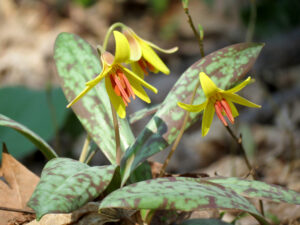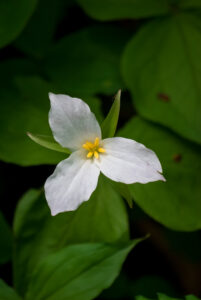Any day now, two wonderful spring wildflowers will blossom on the floor of the Schuylkill Center’s forest, and if you love flowers, if you buy tickets to see the wonderful Philadelphia Flower Show, you really need to see these—and they are free!
The incandescent yellow turban-shaped blossoms of the trout lily are one of the most recognizable features of a Pennsylvania forest in early spring. Rising only 4-6 inches above the soil, the flower is named after the brown-gray mottling of its leaves that resembles something like a trout’s back.
The bright nodding flowers do attract pollinators, and the seeds produced afterward play a clever trick. In a strategy adopted by a range of plants, the seeds sport little caps called elaiosomes, fleshy structures rich in fats (the elaio is Latin for oil) and proteins craved by ants. Worker ants dutifully carry the seeds into their nests to feed the fatty elaiosomes to their larvae. The seeds are then discarded underground—where they grow into plants, the flower essentially bribing ants into sowing its seeds.
The trout lily is also a patient species. The plant quietly produces a single mottled leaf each spring, which photosynthesizes to send starches into its growing underground tuber. Somewhere between four and seven years, the plant has at last stored enough material to produce TWO leaves—and between the two leaves rises the bright yellow flower. Every trout lily flower you see belongs to a plant that could be a decade old—or more…
…for the flower also grows in large colonies, covering, as an example, one entire hillside at the Schuylkill Center; some colonies may be 200 years old. And while that colony could be old, there are remarkably few flowers in the group: only 0.5% of the plants seem to make flowers.
So when you see a trout lily, stop to enjoy its patience, beauty, and age.
The second is white trillium, whose species name, grandiflorum, means “grand flowering.” It is magnificent, as its two- or three-inch bright white petals are among the largest of our spring wildflowers. Like the trout lily, it often grows in clonal colonies that form a white beacon shining on the forest floor in mid-spring. It has no smell, as it does not need one: bumblebees are one of the pollinators lured to the scentless flowers by the color. There is a stand of white trillium in the Blue Ridge Mountains of Virginia estimated to number 10 million individuals: it is worth a trip to visit.
And check out the generic name, Trillium, which simply translates as “tri-lily.” Everything in trillium comes in threes or multiples of threes: three bright white petals, three sepals below the petals supporting them, six pollen-producing anthers topped by three pistils, three greenish-white stigmas atop a six-sided ovary.
You can also tell that it is a member of the lily family, one of the larger families in the botanical world. Examine their leaves and notice the strong parallel veins running their length—these parallel veins are one of the signatures of lilies.
While most white trilliums are just that, white, there are pink and pink-striped variants as well, so you may occasionally stumble upon a pink or pinkish one—it is still white trillium.
Pollinated flowers produce seeds that, also like trout lily, are pulled underground by ants, who add in dispersion and planting.
White trillium—plus many of the lilies—are preferred foods for those dang white-tailed deer, of which there is no shortage in Penn’s Woods. Studies have shown that deer will seek trillium above other plants, which of course causes problems with its survival in many forests. Deer select the taller trillium first, leaving shorter ones behind, allowing keen-eyed scientists to estimate deer density by the height of the trillium. But deer foraging also reduces the plant’s ability to photosynthesize and send sugars and starches into the underground root system. So deer overbrowsing also results in shorter trillium in the forest, if any at all.
But these two are only the tips of a floral iceberg: red trillium, spring beauties, Virginia bluebells, bloodroot, Solomon’s seal, Jack-in-the-pulpit, hepatica, blue cohosh, shooting stars, Jacob’s ladder—all of these and more are set to bloom. But they only blossom for an all-too short window of time, and then disappear for another year.
So come for a walk at the Center, and ask the receptionist for a map and directions to first our Wildflower Loop and then our Ravine Loop. You’ll get a front-row seat at nature’s Flower Show, blossoming right now at the Schuylkill Center.
—Mike Weilbacher, Executive Director


